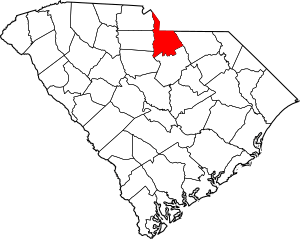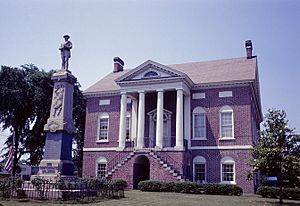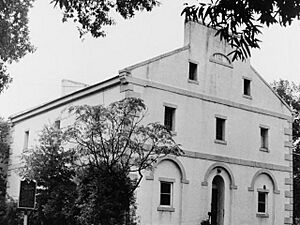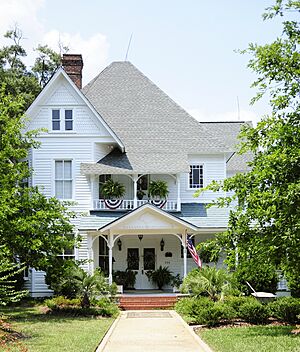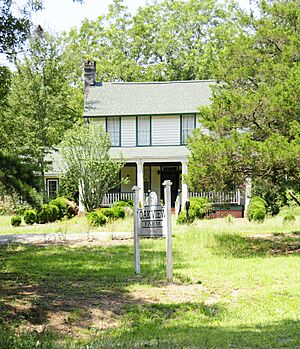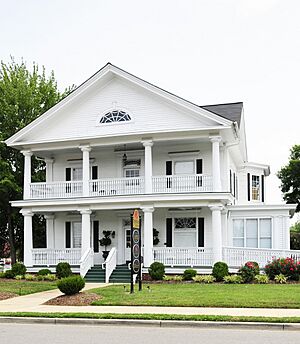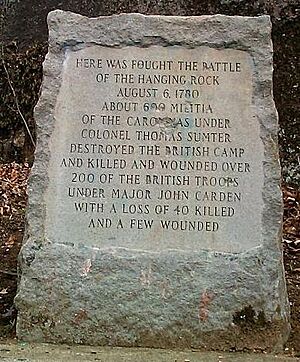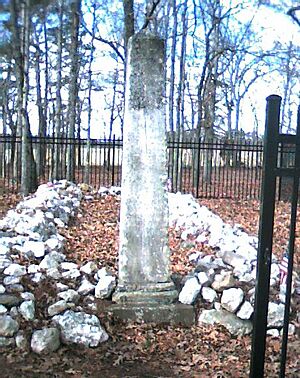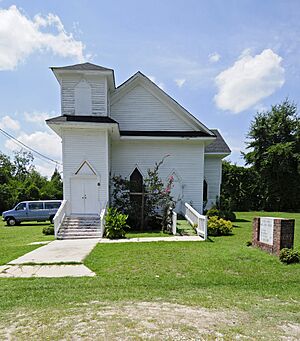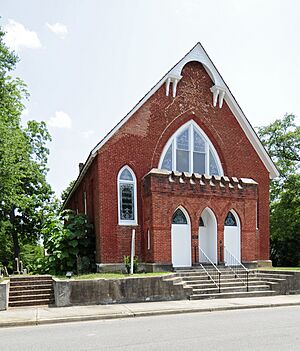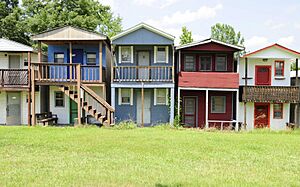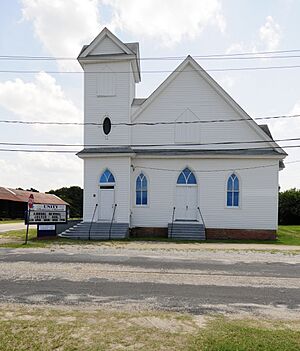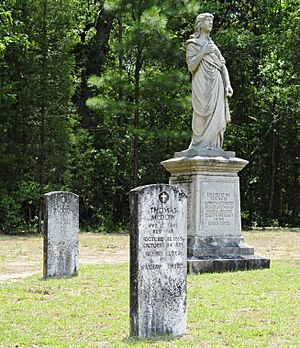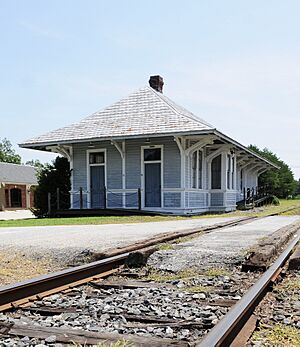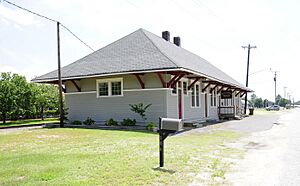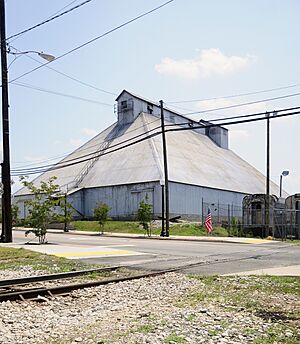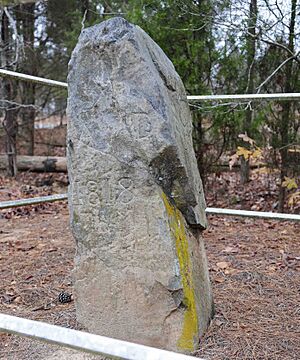National Register of Historic Places listings in Lancaster County, South Carolina facts for kids
This article is about the amazing places in Lancaster County, South Carolina that are listed on the National Register of Historic Places. These are special spots that the United States government has decided are important to our country's history. Think of it like a hall of fame for buildings, battlefields, and other cool sites!
Lancaster County has 27 of these special places. Two of them are even more important and are called National Historic Landmarks. This means they are super significant to the history of the entire country. We'll explore some of these fascinating places and learn why they are so important.
What is the National Register of Historic Places?
The National Register of Historic Places is like a special list of buildings, places, and objects that are important in American history, architecture, archaeology, engineering, or culture. When a place is added to this list, it means it's recognized for its historical value and efforts are made to protect it. It's a way to make sure these important parts of our past are saved for future generations to learn from and enjoy.
Historic Places in Lancaster County
Lancaster County is full of history, from old homes to battlefields. Let's look at some of the most interesting places on the National Register.
Important Buildings and Homes
Many historic homes and buildings in Lancaster County tell stories of the past.
Lancaster County Courthouse
The Lancaster County Courthouse is a very old and important building. It was built way back in 1828! This courthouse has seen a lot of history happen within its walls. It's a great example of early American architecture and how justice was carried out long ago. It's so important that it's one of the two National Historic Landmarks in the county.
Lancaster County Jail
Right near the courthouse is the old Lancaster County Jail, built in 1823. This building also holds many stories from the past. It shows us what jails were like almost 200 years ago. Like the courthouse, it's also a National Historic Landmark, showing its national importance.
Robert Barnwell Allison House
The Robert Barnwell Allison House, built around 1855, is a beautiful old home. It shows us how people lived and what their houses looked like in the mid-1800s. It's a great example of the architecture from that time period.
Dr. William Columbus Cauthen House
The Dr. William Columbus Cauthen House, built in 1904, is another historic home. It belonged to a doctor, and it gives us a peek into the lives of professionals in the early 20th century.
Leroy Springs House
The Leroy Springs House, built in 1906, is a grand home that belonged to a very important person in Lancaster's history, Leroy Springs. He was a successful businessman who helped the town grow. This house reflects the wealth and style of its time.
Historic Battlefields and Sites
Lancaster County was also the scene of important events during the American Revolutionary War.
Battle of Hanging Rock Historic Site
The Battle of Hanging Rock Historic Site is where a big battle happened during the American Revolutionary War in 1780. American forces fought against British troops and their allies. It's a place where you can imagine the brave soldiers who fought for freedom.
Buford's Massacre Site
The Buford's Massacre Site is another important Revolutionary War location. In 1780, a tragic event known as Buford's Massacre (or Waxhaw Massacre) took place here. It was a very tough time for the American soldiers involved. The site reminds us of the sacrifices made during the war.
Churches and Cemeteries
Old churches and cemeteries often hold deep historical and cultural meaning.
Clinton AME Zion Church
The Clinton AME Zion Church, built in 1906, is an important part of the community's history. Churches often served as centers for social life and civil rights movements, especially for African American communities.
Lancaster Presbyterian Church
The Lancaster Presbyterian Church, built in 1862, is a beautiful example of church architecture from the Civil War era. It has been a place of worship and community gathering for over 150 years.
Mount Carmel A.M.E. Zion Campground
The Mount Carmel A.M.E. Zion Campground is a unique historic site. It was used for religious gatherings and revivals, especially by African American communities, starting in the late 1800s. These campgrounds were important places for spiritual and social life.
Unity Baptist Church
The Unity Baptist Church, built in 1906, is another significant church in the county. It shows the importance of faith and community in the lives of people in Lancaster County.
Waxhaw Presbyterian Church Cemetery
The Waxhaw Presbyterian Church Cemetery, established in 1770, is a very old burial ground. It's a quiet place that tells stories of the early settlers and families of the area. Many people who lived and died here helped shape the history of Lancaster County.
Other Interesting Sites
Heath Springs Depot
The Heath Springs Depot, built in 1910, was a train station. Train depots were super important in the past because they were centers for travel and trade. Goods and people came and went from here, connecting Heath Springs to other towns.
Kershaw Depot
Similar to Heath Springs, the Kershaw Depot, built in 1904, was a vital train station for the town of Kershaw. It played a big role in the local economy and helped the town grow.
Lancaster Cotton Oil Company
The Lancaster Cotton Oil Company, built in 1907, was a factory that processed cotton. Cotton was a huge crop in South Carolina, and places like this were essential for turning raw cotton into useful products. It shows the industrial history of the region.
North Carolina-South Carolina Cornerstone
This isn't a building, but a special stone! The North Carolina-South Carolina Cornerstone, placed in 1813, marks the exact border between North Carolina and South Carolina. It's a cool reminder of how state lines were surveyed and established long ago.
Former Listings
Sometimes, a place might be removed from the National Register of Historic Places. This can happen if a building is moved or if it's destroyed.
- Kilburnie: This historic house was once on the list but was removed in 2005 because it was moved to a new location.
- Stewart-Sapp House: Sadly, this house was removed from the list in 2005 because it burned down.
These places, whether still on the list or not, remind us of the rich and interesting history of Lancaster County, South Carolina. They help us connect with the past and understand how our communities came to be.


